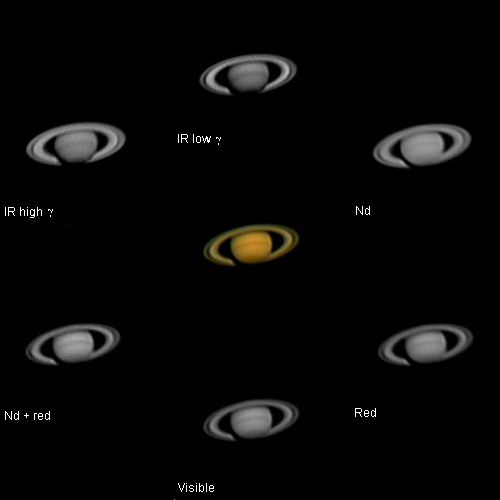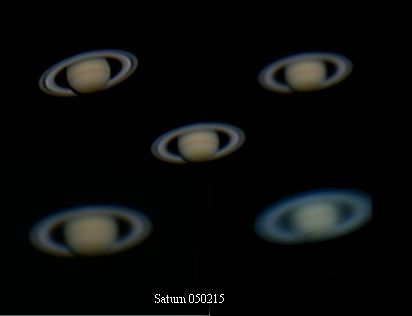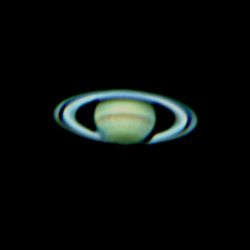

These images cover the 2004/5 season. Saturn reached opposition on 13th January 2005 so it seemed more sensible to keep the pictures for that season together.
The first image here is, I think, the best I have taken with my LX200 and rivals the one I made in 2003 with my ETX125. All the other pictures were taken with my LX200. I think that seeing is more important than almost anything else in getting good images.
The ring system of Saturn was almost fully open in 2003, and so was beginning to close in this season. The Cassini division is an easy target, but the Enke division is beyond the resolution of both my telescopes. The Enke minimum is a dark part of the B ring and is a difficult, but possible, object to record.
The different colours of Saturn in the pictures below are not real. It is difficult to know what the colour should be. The differences are due to different colour balancing in the camera and/or modification in processing.
I experimented quite a lot, this season, with filters and lenses, so the pictures here largely reflect those experiments.
 |
Have I at last got a picture of Saturn to rival that taken almost two years
ago with my ETX? I've had to enhance this image maybe a little
too much in order to bring out the whole of the Cassini division and just a hint
of the Enke minimum on the right. The picture was taken at prime focus of
my LX200 on 7th February 2005. To be fair, the closing up of the rings in the two years since I took the picture with the ETX, has made imaging the divisions somewhat more difficult. Date and Time: 7th February 2005 21:39 UT Set-up: ToUcam 740K on the LX200 Capture: K3CCDTools, 1/33", 18% gain. 606 frames Processing: K3CCDTools Planetary wizard, 70% of frames, X2. Histogram 0-160, Unsharp mask 5,100 Registax, wavelets 1 = 15, 2 = 5, 3 = 2. Slight adjustment of colour in PhotoImpact. |
 |
This is an experiment to assess the effects of different wavelengths of light. All were taken at prime focus of my LX200 within 30 minutes. The central image is, obviously, the one in natural light (just an IR-blocking filter). The others are all rendered into monochrome because that is what the images in IR are and the ones with coloured filters looked very unnatural in colour. There are two pictures in IR light, one with a high gamma and one with a low (all the rest are with a low gamma); these pictures were made by substituting the IR-blocking filter with an IR-pass filter (made from colour film). The other images were all made with the IR-blocking filter in place. Nd is a Neodymium filter; this is a narrow-band, anti-pollution filter that blocks fairly narrow bands in the green and orange part of the spectrum. Red is a Parks No.21 orange filter; combined with the Nd filter I get a dark red filter. The image marked Visible is simply the one in the centre rendered in monochrome for comparison. The IR pictures should be compared with those I took in 2003. Date and Time: 24th March 2005 between 20:49 and 21:13 UT Set-up: ToUcam 740K on the LX200, prime focus with filters as indicated. Capture: K3CCDTools, IR 1/25", Nd 1/50", Red and natural 1/33", gain as appropriate to give about 150 on the K3meter. Processing: Registax, resampling X2; wavelets 1,2 = 10, 3 = 5, Histogram 0 - 200. |
 |
This is an experiment to assess the effects of barlow lenses. The four images in the corners
were all made the same night and with the same processing, but with different barlow lenses.
One picture is at prime focus and the other three are with (i) my X2 SLR adaptor lens, (ii) a Meade
X3 barlow (the cheap one!), (iii) a X5 Powermate (not cheap at all!). Moving your mouse over
the image will reveal which is which. The centre image is the same as one of the others but whereas
the others were processed in Registax with X2 resampling, this image used no resampling. I leave you
to draw your own conclusions. Click here for a further discussion. Date and Time: 15th February 2005 between 20:15 and 21:00 UT Set-up: ToUcam 740K on the LX200, barlow lenses as indicated Capture: K3CCDTools, 1/25", gain as appropriate (image at prime focus was taken with 1/33") Processing: Registax, resampling X2 except as indicted; wavelets 1,2 = 10. |
 |
In my location a light-pollution filter is a necessity for DSOs, so I tried it
on Saturn as well. By adding an Orange filter I isolated the deep red; for an
emission nebula this effectively isolated the Hα line but for the Sun it will
pass a broader band in the red. The orange filter does, however, block the
blue-green band passed by the light-pollution filter. Date and Time: 19th December 2004 22:16 and 00:37 UT Set-up: ToUcam 740K on the LX200 Capture: K3CCDTools, 1/25", 34% gain Processing: Registax, wavelets 2 - 5 = 10. |
 |
My first picture of the new season. Saturn was only 27° up, at a distance
of 1,445 million Km and subtended an angle of 17 arc sec. Date and Time: 6th September 2004 03:51 UT Set-up: ToUcam 740K with X2 lens on the LX200 Capture: K3CCDTools, 612 frames, low gamma, 1/25", 40% gain Processing: Registax, 458 frames stacked, wavelets 1,2 = 10, colours aligned. |